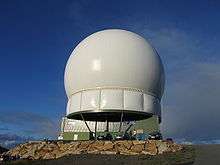Globus II
Globus II is a radar station located at 70.3671°N 31.1271°E in Vardø, Norway, near the Russian border.[1]

Purpose and use
The site is administrated by the Norwegian Intelligence Service, which states that the radar is used for:[2]
- Space surveillance
- Surveillance of areas of national interest abroad
- Gather information of interest to research and development
The radar was previously known as "Have Stare" and located at Vandenberg Air Force Base, California. It was made by Raytheon, who previously described it on their website as a radar "originally designed to collect intelligence data against ballistic missiles". The website has since then been removed by request of the US DoD.[3][4]
The radar, which uses a mechanically steered 27-meter dish antenna, is believed to have similar, though probably somewhat more limited, capabilities as the newer American Sea-based X-band Radar used in the Ground-Based Midcourse Defense anti-ballistic missile system.
Controversy
When the radar was built the Norwegian official statement was that it was going to be used to monitor objects in space, such as satellites and space debris. This information was to be added to the orbital database provided by the US Space Command.
In April 1998 a Norwegian journalist, Inge Sellevåg, from the daily newspaper Bergens Tidende discovered that NASA had no knowledge of a new radar being added to the system. This led him to suspect it had other purposes and Mr. Sellevåg discovered that it was also going to be used for national purposes such as intelligence gathering.[4]
In 2000, during a storm, the radome was torn off and uncovered the radar-dish.[5] At that time it was pointing directly towards Russia. A local newspaper editor commented: "I'm not an expert, but I thought space was in the sky." Official comments claimed that the radar was still being tested and that it pointed towards Russia was a pure coincidence. The Russian general Leonid Ivashov said in a statement to the Norwegian newspaper, Dagbladet, that Russia had programmed tactical nuclear weapons to attack the radar station.
Today, it is believed that Globus II has an important role in the US anti-ballistic missile system. Located near the Russian border it is highly capable of monitoring and building a signature database of Russian missiles. In addition, Vardø is well placed for the radar to collect precision data on the warheads and decoys carried by missiles bound for the United States on a transpolar trajectory. These considerations, together with the questionable nature of the advantages of Globus II as a space surveillance sensor, have led to even more controversy, including a series of official complaints by Russia.
Administration and funding
The radar is administered by the Norwegian Intelligence Service. It is however believed to be connected to the US radar network. Although the cost of the radar is classified, it is believed to have cost more than 100 million US dollars[5] and that it was financed by the United States. The Norwegian intelligence service claims that it is operated by Norwegian personnel only and that data is not transferred real-time. What is to be considered real-time is however disputed as such radar-stations collect too much information for it to be transferred live. Instead, information is typically automatically filtered on location and transferred in batches every 30–90 seconds
A new radar, GLOBUS 3, is currently under construction.[6][7] On 13 February 2018 it was reported that the local population felt misled about the size of the radar. The construction work was shrouded in secrecy, and many locals were critical, but they were reluctant to speak out because the project brought sorely needed employment to the community.[8]
References
- Globus II/Have Stare Sourcebook
- Etterretningstjenesten. "Globus II: Oppgaver" (in Norwegian). Archived from the original on 13 October 2003.
- Raytheon Systems Company (15 November 1999). "AN/FPS-129 HAVE STARE" (PDF). Center for Arms Control, Energy and Environmental Studies. Retrieved 27 May 2016.
- Sellevåg, Inge (March–April 2000). "Vardø Exposed". Bulletin of the Atomic Scientists. 56 (2): 26–29. doi:10.1080/00963402.2000.11456939.
- Higgins, Andrew (6 June 2000). "How A Storm Spread A Cold War Chill". The Wall Street Journal. Retrieved 3 September 2017.
- "Modernisering av radaranlegget i Vardø" (in Norwegian). Norwegian Armed Forces. April 6, 2016. Archived from the original on 14 June 2017.
- Higgins, Andrew (13 June 2017). "On a Tiny Norwegian Island, America Keeps an Eye on Russia". The New York Times. Retrieved 14 June 2017.
- Wormdal, Bård (13 February 2018). "Lokalbefolkningen raser mot feilinformasjon om ny topphemmelig radar". NRK (in Norwegian).
External links
- AN/FPS-129 HAVE STARE X-Band Dish radar, GlobalSecurity.org
- "Pentagons øye?" [The Pentagon's eye?]. Brennpunkt (in Norwegian). NRK. 11 October 2005.